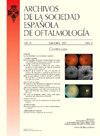Estudio de un banco de tejidos en Galicia. Características y evolución del trasplante de córnea entre 2016 y 2022 en Galicia
Q3 Medicine
Archivos De La Sociedad Espanola De Oftalmologia
Pub Date : 2025-05-01
DOI:10.1016/j.oftal.2025.01.013
引用次数: 0
Abstract
Objective
To describe the characteristics of donated and transplanted corneas, trends in surgical techniques, and indications for corneal transplantation, and the impact of COVID-19 on a Spanish tissue bank from 2016 through 2022.
Methods
We conducted a retrospective analysis of corneal donation records from Complejo Hospitalario Universitario de A Coruña Cryobiology Unit and Tissue Bank from January 1st, 2016 through June 30th, 2022.
Results
Corneal donations and transplants remained stable over 6.5 years, except for declines in 2020–2021. A total of 44.3% of all donated corneas were not transplanted, mainly due to tissue viability issues (41.4%). Donors averaged 60.2 ± 13 years, with a mean corneal endothelial cell count of 2701.3 ± 324.6 cells/mm2 and a mean corneal clear zone diameter of 7.7 ± 0.7 mm. The preferred preservation method for keratoplasty was hypothermia (85.9%). Indications included endothelial dysfunction (53.8%), repeated keratoplasty (18.8%), corneal ectasia (15.4%), stromal opacity (7.6%), and tectonic causes (4.9%). Penetrating keratoplasty (PK) was more common (56.3%) than lamellar techniques (43.7%), but endothelial keratoplasty (EK) increased by 27.8% since 2019. EK, predominantly Descemet Membrane Endothelial Keratoplasty (DMEK, 94.1%), was used in 96.7% of endothelial dysfunction cases, although 28.6% were treated with PK. Deep anterior lamellar keratoplasty was primarily used for corneal ectasia (46.8%).
Conclusions
The Galicia Tissue Bank exceeds the European Eye Bank Association quality standards. Penetrating techniques remain predominant, but the trend is towards favor lamellar procedures, particularly DMEK. Endothelial dysfunction is the leading and growing indication for corneal transplantation.
在加利西亚研究一个组织库。加利西亚2016 - 2022年角膜移植的特点和演变
目的分析2016 - 2022年西班牙某组织库角膜捐献与移植的特点、手术技术发展趋势、角膜移植适应证及新冠肺炎疫情对组织库的影响。方法回顾性分析2016年1月1日至2022年6月30日,来自西班牙综合医院(Universitario de a) Coruña冷冻生物学单位和组织库的角膜捐赠记录。结果除了2020-2021年下降外,捐献和移植数量在6.5年内保持稳定。共有44.3%的捐献角膜没有被移植,主要是由于组织活力问题(41.4%)。供者平均年龄60.2±13岁,平均角膜内皮细胞计数为2701.3±324.6个细胞/mm2,平均角膜透明区直径为7.7±0.7 mm。首选的保存方法是低温(85.9%)。适应症包括内皮功能障碍(53.8%)、反复角膜移植(18.8%)、角膜扩张(15.4%)、间质混浊(7.6%)和构造原因(4.9%)。穿透性角膜移植术(PK)比板层技术(43.7%)更常见(56.3%),但内皮性角膜移植术(EK)自2019年以来增加了27.8%。EK,主要是Descemet膜内皮角膜移植术(DMEK, 94.1%),用于96.7%的内皮功能障碍病例,尽管28.6%的患者接受了PK治疗。深前板层角膜移植术主要用于角膜扩张(46.8%)。结论加利西亚组织库超过了欧洲眼库协会的质量标准。穿透技术仍然占主导地位,但趋势是有利于层状工艺,特别是DMEK。内皮功能障碍是角膜移植的主要和日益增长的适应症。
本文章由计算机程序翻译,如有差异,请以英文原文为准。
求助全文
约1分钟内获得全文
求助全文
来源期刊

Archivos De La Sociedad Espanola De Oftalmologia
Medicine-Ophthalmology
CiteScore
1.20
自引率
0.00%
发文量
109
审稿时长
78 days
期刊介绍:
La revista Archivos de la Sociedad Española de Oftalmología, editada mensualmente por la propia Sociedad, tiene como objetivo publicar trabajos de investigación básica y clínica como artículos originales; casos clínicos, innovaciones técnicas y correlaciones clinicopatológicas en forma de comunicaciones cortas; editoriales; revisiones; cartas al editor; comentarios de libros; información de eventos; noticias personales y anuncios comerciales, así como trabajos de temas históricos y motivos inconográficos relacionados con la Oftalmología. El título abreviado es Arch Soc Esp Oftalmol, y debe ser utilizado en bibliografías, notas a pie de página y referencias bibliográficas.
 求助内容:
求助内容: 应助结果提醒方式:
应助结果提醒方式:


